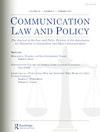Freedom of Expression: Another Look at How Much the Public Will Endorse
IF 0.2
Q4 LAW
引用次数: 0
Abstract
Since World War II, U.S. citizens have reported overwhelming agreement that freedom of expression is a basic right. But, like the law on free expression, public opinion shows that citizen rights to free expression are not absolute or unidimensional, but conditional. To better understand the extent of citizen rights to free expression according to the U.S. public, this study examines data from an online national survey (N = 2,600) in which twenty-five types of expression were offered for respondent agreement that “U.S. citizens should have a right to….” According to the respondents, the free expression types to which citizens have the most rights were expressing political opinions, making a political speech, picketing as a union member, and wearing a black armband in protest. The least endorsed rights were lying in the news, lying generally, protesting outside a church funeral service for a veteran, using racist language in a speech, and burning the American flag. Demographic analyses showed agreement with rights to free expression was highest among younger respondents, non-whites and males. Further analysis confirmed that freedom of expression is not unidimensional, with four main dimensions underlying perceptions of the twenty-five types. These dimensions were identified as repugnant expression, historical political expression, un-patriotic expression, and avoiding compelled expression.言论自由:再看公众会支持多少
自第二次世界大战以来,美国公民普遍认为言论自由是一项基本权利。但是,就像言论自由的法律一样,民意表明,公民的言论自由权利不是绝对的或单向度的,而是有条件的。为了更好地了解美国公众的公民言论自由权利的程度,本研究检查了一项在线全国调查(N = 2,600)的数据,其中提供了25种表达方式,供受访者同意“美国的言论自由”公民应该有权利....”据应答者的回答,市民最应享有的言论自由是发表政治意见、发表政治演说、以工会成员身份进行示威、佩戴黑色臂章等。最不被认可的权利是在新闻中撒谎,普遍撒谎,在教堂为一名退伍军人举行的葬礼上抗议,在演讲中使用种族主义语言,焚烧美国国旗。人口统计分析显示,年轻受访者、非白人和男性对言论自由权利的认同程度最高。进一步的分析证实,言论自由不是单向度的,对25种类型的看法有四个主要方面。这些维度被确定为反感表达、历史政治表达、不爱国表达和避免强迫表达。
本文章由计算机程序翻译,如有差异,请以英文原文为准。
求助全文
约1分钟内获得全文
求助全文
来源期刊
CiteScore
0.60
自引率
33.30%
发文量
7
期刊介绍:
The societal, cultural, economic and political dimensions of communication, including the freedoms of speech and press, are undergoing dramatic global changes. The convergence of the mass media, telecommunications, and computers has raised important questions reflected in analyses of modern communication law, policy, and regulation. Serving as a forum for discussions of these continuing and emerging questions, Communication Law and Policy considers traditional and contemporary problems of freedom of expression and dissemination, including theoretical, conceptual and methodological issues inherent in the special conditions presented by new media and information technologies.

 求助内容:
求助内容: 应助结果提醒方式:
应助结果提醒方式:


